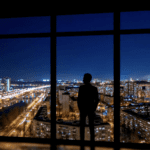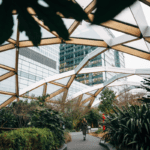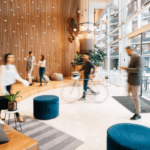
Can Proactive Lighting Support Actually Make Your Office More Sustainable?
90% of commercial buildings have a 2030 carbon neutral goal.
Buildings are responsible for consuming about one-third of the world’s energy resources, making them the foundation for an energy efficient future. Converging forces are driving the need for companies to attain aggressive ESG and decarbonization goals. The ability to attract and retain talent, investor considerations, new regulations, and an authentic consideration for our planet are setting sustainability as a high priority at the C-suite.
In the race towards 2030 carbon neutral objectives, major investments are being made to optimize building operations to lower their carbon footprint and increase energy efficiency. With the push to adopt the latest technologies to meet ESG KPIs, a less than optimal pattern is emerging across most implementations and deviates far from what was intended at purchase. Below is an example of a common lifecycle:
- An energy-saving building technology solution is identified and purchased
- The solution is tailored to satisfy your requirements for that point in time
- KPIs (Key Performance Indicators) are set, reflecting current goals and an in-house champion is trained, along with operating personnel
- The solution operates as advertised, but suddenly there is a shift in the real estate market, in energy prices, in working norms, interest rates or one of several other factors
- The once promising energy saving solution is no longer serving the needs of the business
To optimize investments and build a sustainability portfolio through shifting market factors, ongoing metrics need to be evaluated and re-established. Just as important, vendor check-ins to learn about additional capabilities, exploration of integrations and continued education as a hedge against attrition are essential to ensure building technologies keep pace and contribute to ESG objectives. This is where excellence in customer service can help meet these ongoing challenges.
Four Lighting Support Opportunities to Boost Sustainability
Ensuring maximum energy savings from an automated lighting system requires attention to detail, continuous review, and a deep understanding of data and available tools. A solid customer support partner unlocks the ability of facilities teams to become proficient in finding new ways to continuously improve their spaces.
- Profile Analysis: After initial installation of a lighting control system, it is imperative to continue analyzing lighting profiles to ensure they are optimized to save energy. A profile configuration value determines the light level settings of a fixture. These settings are used by the sensor along with the time of day, day of the week, and time duration to control the fixture’s light level. As lighting accounts for the highest electricity consumer in a building, tuning these settings for greatest efficiency is the quickest way to realize further energy savings. To accomplish this, an excellent customer support model would schedule a regular review to examine:
- High impact profiles: What’s driving most of the energy spend within the environment? Does the reason for this situation still exist or have the building uses changed since the settings were established?
- Profile settings and savings methods: What tips and techniques for setting profile values can be employed?
- Occupant impact: How can the impact to occupants be minimized or even improved with the right profile settings?
- Consumption Tracking & System Configuration: Understanding how to monitor energy consumption is the first step to achieving maximum savings. An exceptional support program will demonstrate how to monitor watt-hour energy usage of the building, floor, area, and fixture level and will examine the full scope of your system. Identification of cause and effect from these patterns is the first step to begin optimizing for greater energy savings.
- Setting baselines: Understand patterns by time periods to align with shifts in space use and trends.
- Consumption analysis: Optimize path-forward savings by recognizing what has resulted in efficiencies in the past.
- Trending data YoY to set new baselines: Identify big shifts in space use, energy costs, traffic flow and recognize when new baselines need to be established
- Understanding Facility Utilization and Impact to Energy Use: Occupancy observations from a typical day/week/month can uncover the most heavily utilized spaces, heavy traffic flow patterns and areas that are less utilized or are used for shorter periods of time. As a valued support option, a space expert can provide the right analysis of facilities to suggest possible reconfigurations or changes to the lighting configurations:
- Identification of low-use spaces that do not require continuous lighting
- Ways to group zones based on new uses and purpose
- Identification of whole areas that can be consolidated, resulting in decommissioned space with significant operational and energy savings
- Motion Grouping Analysis: Understanding grouping will allow lighting controls to work in a harmonious way, improving user comfort as well as removing large, under-utilized areas. A motion grouping is a group of sensors that acts and behaves in unison when motion is detected. If any one sensor in the group detects motion, they will all turn on. Single, large motion groups are a large source of wasted energy. They can be setup initially in what was supposed to have been the most occupied area, but with changes might not be currently 100% utilized. There are several ways to change motion grouping to save energy, including breaking the motion group into overlapping segments. This allows for more granular use of the space. By overlapping the motion groups, spaces can be well lit before any occupants enter. Combining this motion grouping technique with more aggressive motion time-outs or even the dim and linger features will save substantial energy. During a customer support session, the benefits and logistics of groupings can be examined:
- How to review motion groups to identify and correct inefficiencies
- Understanding switches & switch groups and their impact on consumption
- Recommendations for new groupings likely to result in minimal occupant impact with maximum savings
Summary: Don’t Set it and Forget it
At Enlighted we consider the installation of a new software-defined lighting system as only the beginning. With the combination of refined energy reporting, data-enabled insights and excellence in customer support, we’re dedicated to helping our customers continuously tune their systems to maximize efficiency. As part of Siemens with a net carbon zero goal of 2030, we well understand the mission of our customers and are committed to helping them get there – despite whatever market shifts come our way together.
The brightest way to operate, orchestrate, and optimize everyday spaces.


